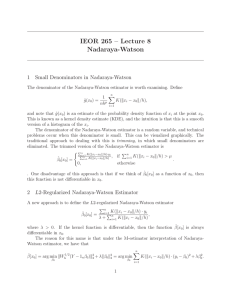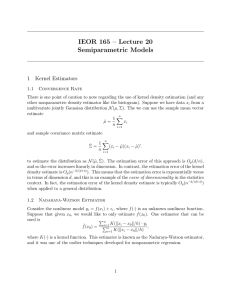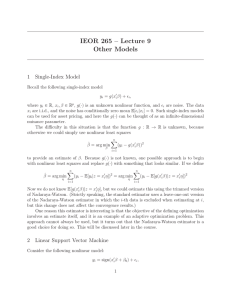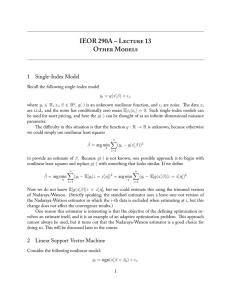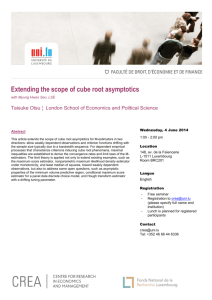IEOR 290A – L 10 N-W 1 Definition of Nadaraya-Watson Estimator
advertisement
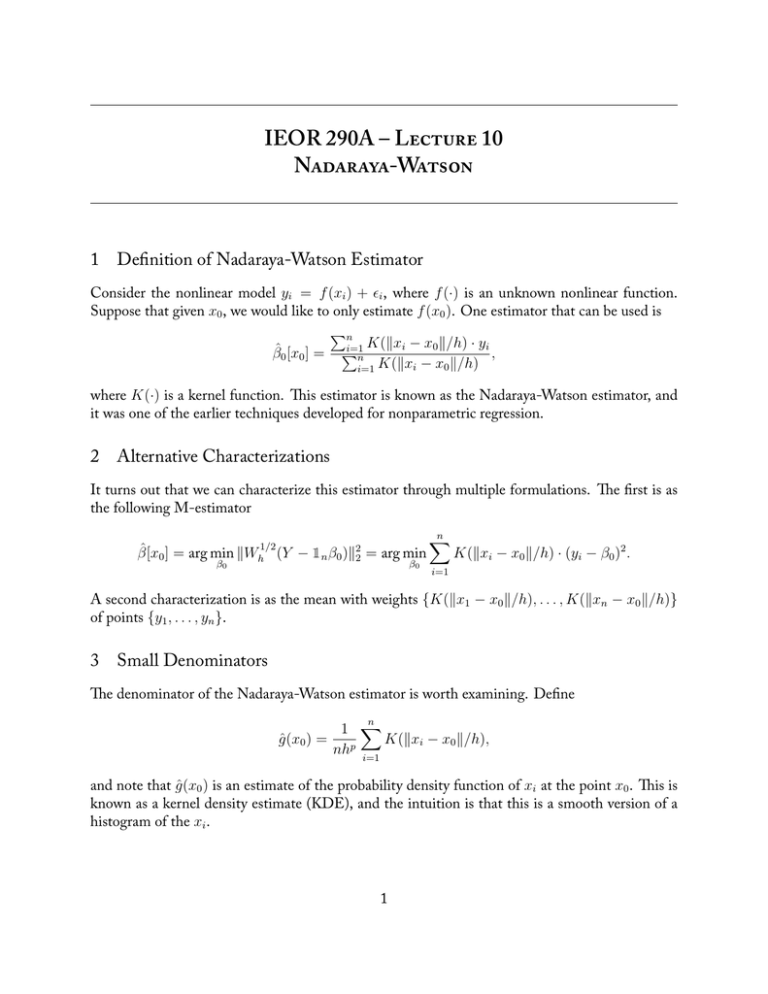
IEOR 290A – L 10
N-W
1
Definition of Nadaraya-Watson Estimator
Consider the nonlinear model yi = f (xi ) + ϵi , where f (·) is an unknown nonlinear function.
Suppose that given x0 , we would like to only estimate f (x0 ). One estimator that can be used is
∑n
i=1 K(∥xi − x0 ∥/h) · yi
β̂0 [x0 ] = ∑
,
n
i=1 K(∥xi − x0 ∥/h)
where K(·) is a kernel function. is estimator is known as the Nadaraya-Watson estimator, and
it was one of the earlier techniques developed for nonparametric regression.
2
Alternative Characterizations
It turns out that we can characterize this estimator through multiple formulations. e first is as
the following M-estimator
β̂[x0 ] =
1/2
arg min ∥Wh (Y
β0
−1
2
n β0 )∥2
= arg min
β0
n
∑
K(∥xi − x0 ∥/h) · (yi − β0 )2 .
i=1
A second characterization is as the mean with weights {K(∥x1 − x0 ∥/h), . . . , K(∥xn − x0 ∥/h)}
of points {y1 , . . . , yn }.
3
Small Denominators
e denominator of the Nadaraya-Watson estimator is worth examining. Define
n
1 ∑
ĝ(x0 ) =
K(∥xi − x0 ∥/h),
nhp i=1
and note that ĝ(x0 ) is an estimate of the probability density function of xi at the point x0 . is is
known as a kernel density estimate (KDE), and the intuition is that this is a smooth version of a
histogram of the xi .
1
e denominator of the Nadaraya-Watson estimator is a random variable, and technical problems occur when this denominator is small. is can be visualized graphically. e traditional approach to dealing with this is trimming, in which small denominators are eliminated. e trimmed
version of the Nadaraya-Watson estimator is
{ ∑n K(∥x −x ∥/h)·y
∑n
0
i
i
i=1
∑
,
if
n
i=1 K(∥xi − x0 ∥/h) > µ
K(∥x
−x
∥/h)
0
i
i=1
.
β̂0 [x0 ] =
0,
otherwise
. One disadvantage of this approach is that if we think of β̂0 [x0 ] as a function of x0 , then this
function is not differentiable in x0 .
4
L2-Regularized Nadaraya-Watson Estimator
A new approach is to define the L2-regularized Nadaraya-Watson estimator
∑n
K(∥xi − x0 ∥/h) · yi
i=1
∑n
β̂0 [x0 ] =
,
λ + i=1 K(∥xi − x0 ∥/h)
where λ > 0. If the kernel function is differentiable, then the function β̂[x0 ] is always differentiable
in x0 .
e reason for this name is that under the M-estimator interpretation of Nadaraya-Watson
estimator, we have that
β̂[x0 ] = arg min ∥Wh (Y − 1n β0 )∥22 + λ∥β0 ∥22 = arg min
1/2
β0
β0
n
∑
K(∥xi − x0 ∥/h) · (yi − β0 )2 + λβ02 .
i=1
Lastly, note that we can also interpret this estimator as the mean with weights
{λ, K(∥x1 − x0 ∥/h), . . . , K(∥xn − x0 ∥/h)}
of points {0, y1 , . . . , yn }.
2


